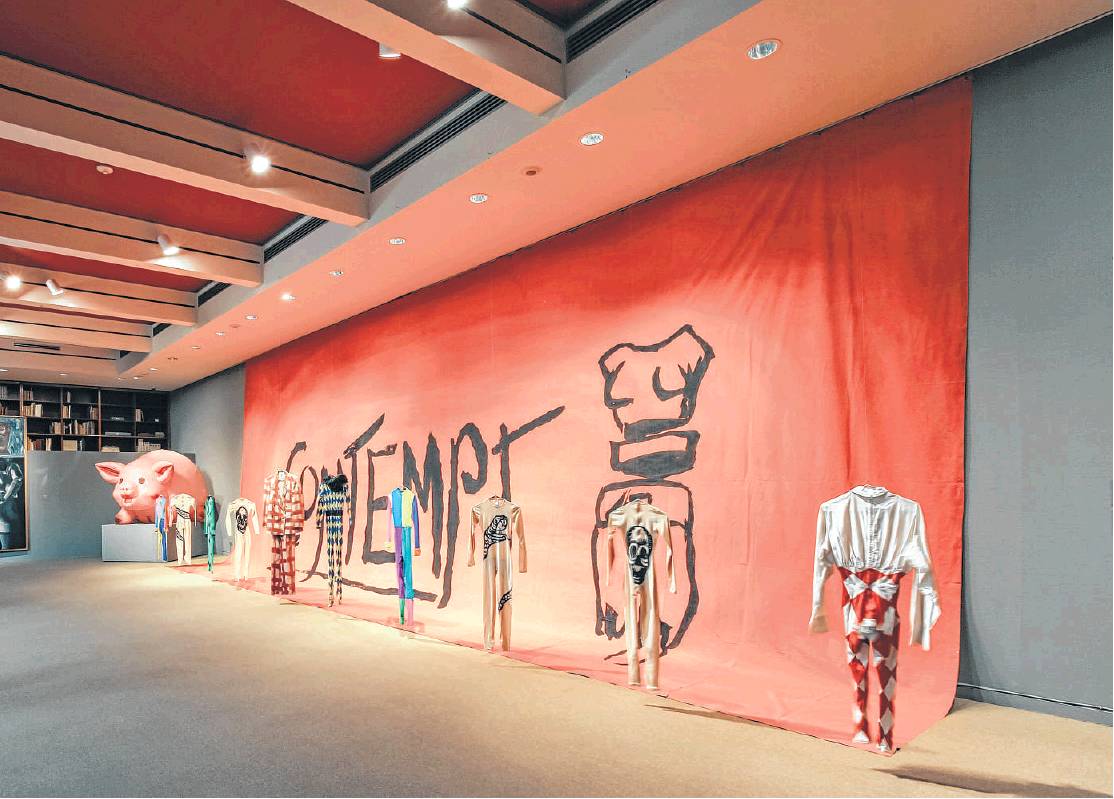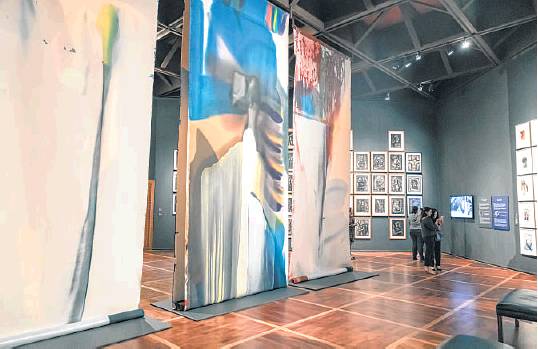If pigs could dance? This one did
Inflatable porker among the costumes, backdrops and performance videos in exhibit
By Deborah Martin STAFF WRITER
There’s lots of cool stuff in “Painting for Performance,” including costumes, backdrops and videos of performances.
But the showstopper just might be the enormous pink pig tucked into a corner of the Tobin Theatre Arts Wing of the McNay Art Museum. Jeff Koons designed the inflatable costume — that’s right, a dancer wore the polyvinyl creation — for choreographer Karole Armitage’s 1989 piece about shattered relationships titled “Contempt.”
The dancer inside the pig had a lot to contend with, said Tobin Theatre Arts Fund assistant curator Timothy James Retzloff, who pulled the show together with René Paul Barilleaux, the McNay’s head of curatorial affairs.
“We found out that the dancer had to wear a battery pack and a blower and try to hear the music and dance at the same time,” Retzloff said.
For the exhibit, McNay staffers upgraded the clunky, jury-rigged system, worn by the dancer to keep the pig inflated, to the kind of blower used for inflatable holiday yard decorations.
Koons is one of five visual artists whose design work for opera or dance are spotlighted in the exhibit.
The others are Georges Rouault, Paul Jenkins, Terry Winters and David Salle. Salle worked with Koons on “Contempt” and created the piece’s vivid backdrop, which is on display beside the pig.
Salle and Koons collaborated on the costumes for the piece. The nonporcine ensembles in the exhibit are hung on wires rather than displayed on dress forms, a choice aimed at animating the clothing.
“René had a brilliant idea of suspending them from the ceiling, and they move, which, for dance, is what you need,” Retzloff said.
The idea behind the show was to highlight performance designs by visual artists not typically associated with the stage.
“You have some of these dance companies engage some of the big name artists of the time to come collaborate on some of these smaller projects,” Retzloff said. “They’re not these big Broadway shows. They’re organic dance projects.”
Visual artists and dance companies jibe well, Barilleaux said.
“Kind of traditionally, and more recently, visual artists and dance come together more than visual artists and theater,” he said. “This is the world where you have more experimentation.”
The exhibit ties in with “Picasso to Hockney: Modern Art on Stage,” the museum’s upcoming big fall show also spotlighting theatrical design by visual artists. It opens Thursday.
“This is sort of an outgrowth of ‘Picasso to Hockney,’ ”Barilleaux said. “There were some artists I was interested in, and so I decided to pull them out and develop a separate project.”
“Painting for Performance” has one opera in the mix — the 1987 Paris Opera production of “Shaman to the Prism Seen,” for which Paul Jenkins designed the enormous abstract backdrops that hang in the center of the first gallery — but most of the focus is on dance.
That’s partly because Barilleaux is a big dance fan — the idea for the show started taking root when he saw a New York City Ballet revival of George Balanchine’s “Prodigal Son” — and partly as an effort to spotlight an art form that doesn’t often pop up in the Tobin galleries.
“We typically focus on stage dramas and musicals,” Barilleaux said. “This is an opportunity to focus more on modern and contemporary dance.”
Rouault’s designs for “Prodigal Son” are in the show, as is video of a performance.
Video can be found throughout the exhibit, giving visitors the opportunity to see the design elements in context. In addition, there is a soundscape of music from the works.
The exhibit also includes other artwork by the featured artists in which they deal with themes that connect to their designs. A suite of Rouault’s work hangs on one wall in its entirety.
“They’re portfolio prints, so they’re not usually presented this way,” Barrilleaux said. “I kind of was thinking of it almost as the audience looking at the performers. So it has this very theatrical, cinematic effect.”
Salle and Terry Winters, who is represented by his designs for work by choreographers Merce Cunningham and Trisha Brown, hand-picked the related works in the exhibit.
“We really want to emphasize both their visual art and their performance work equally,” Barrilleaux said. dlmartin@express-news.net “Painting for Performance” can be seen through Dec. 8 at the McNay Art Museum, 6000 N. New Braunfels Ave. mcnayart.org; 210-824-5368.


